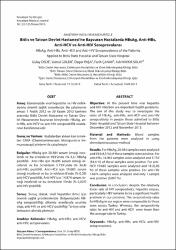Bitlis ve Tatvan Devlet Hastanesi’ne başvuran hastalarda HBsAg, Anti-HBs, Anti-HCV ve Anti-HIV seroprevalansı
Abstract
Amaç: Günümüzde viral hepatitler ve HIV enfeksiyonu
önemli sağlık sorunlarıdır. Bu çalışmanın
amacı 1 Aralık 2012 ve 30 Kasım 2013 tarihleri
arasında Bitlis Devlet Hastanesi ve Tatvan Devlet
Hastanesine başvuran bireylerde; HBsAg, anti-HBs,
anti-HCV ve anti-HIV seropozitiflik oranlarının
belirlenmesidir.
Gereç ve Yöntem: Hastalardan alınan kan örnekleri
CMIA (Chemiluminescent Microparticle İmmunoassay)
yöntemi ile çalışılmıştır.
Bulgular: HBsAg için 20.484 serum örneği incelendi
ve bu örneklerin 933’ünde (% 4,5) HBsAg
pozitifdi. Anti-HBs için 16.695 serum örneği incelendi
ve bu örneklerin 5.759’unda (% 34,4)
anti-HBs pozitifdi. Anti-HCV için 19.685 serum
örneği incelendi ve bu örneklerin 8’inde (% 0,09)
anti-HCV pozitifdi, Anti-HIV için 14.874 serum örneği
incelendi ve bu örneklerin 1’inde (% 0,007)
anti-HIV pozitifdi.
Sonuç: Sonuç olarak, viral hepatitler ilimiz için
önemli sağlık problemleridir. Bölgemizdeki HBsAg
seropozitifliği ülkemiz oranlarıyla uyumlu
olup, anti-HIV ve anti-HCV pozitifliği Türkiye ortalamasının
altında çıkmıştır. Objective: At the present time viral hepatitis
and HIV infection are important health problems.
The aim of this study was to investigate the
rates of HBsAg, anti-HBs, anti-HCV and anti-HIV
seropositivity in people those admitted to Bitlis
State Hospital and Tatvan State Hospital between
December 2012 and November 2013.
Material and Methods: Blood samples
from the patients were analysed in using
chemiluminescence method.
Results: For HBsAg, 20.484 samples were analyzed
and 933 (4,5 %) of these samples were positive. For
anti-HBs, 16.965 samples were analyzed and 5.759
(34,4 %) of these samples were positive. For antiHCV
19.685 samples were analyzed and 18 (0,09
%) of these samples were positive. For anti-HIV
14874 samples were analyzed and only 1 sample
was positive (0,007 %).
Conclusion: In conclusion; despite the relatively
lower rate of HIV seropositivity, hepatitis viruses,
particularly HBV remains to be a significant health
problem in our province. The seropositivity rates
for HBsAg in our region were comparable to those
seen across Turkey. Whereas, the seropositivity
rates for anti-HIV and anti-HCV were lower than
the average rate in Turkey.
Source
Afyon Kocatepe Üniversitesi, Kocatepe Tıp DergisiVolume
16Issue
2Collections
- Kocatepe Tıp Dergisi [154]



















